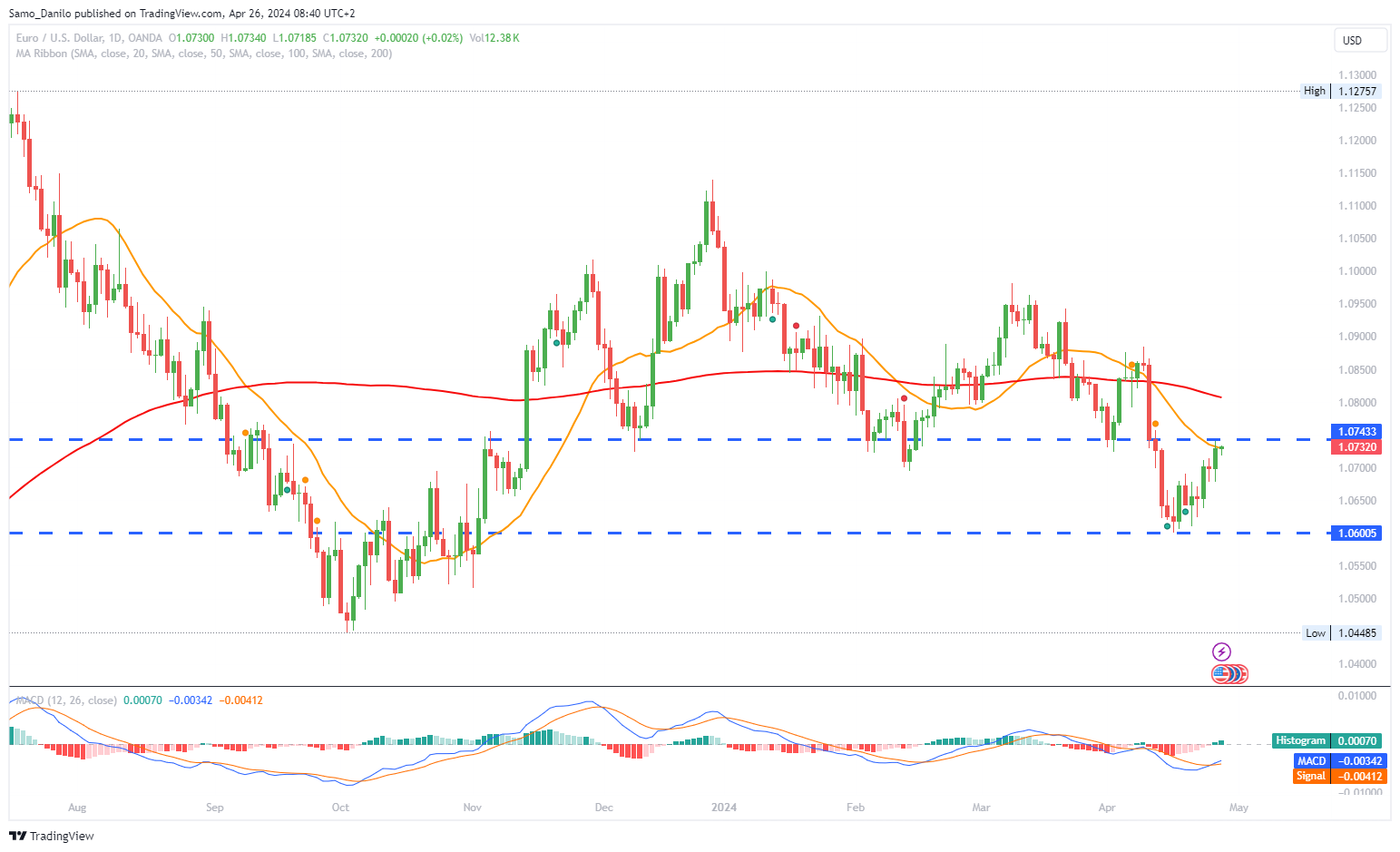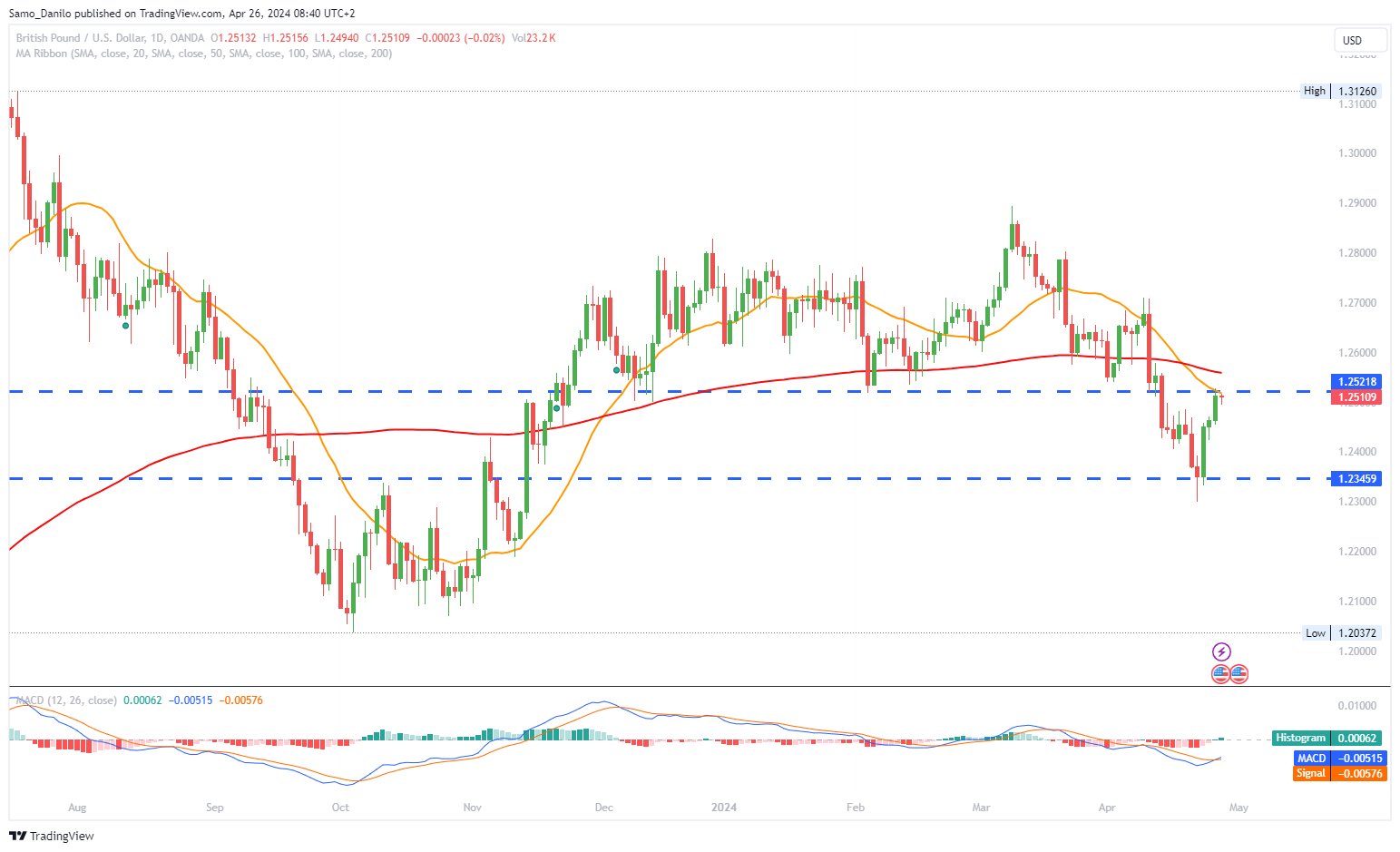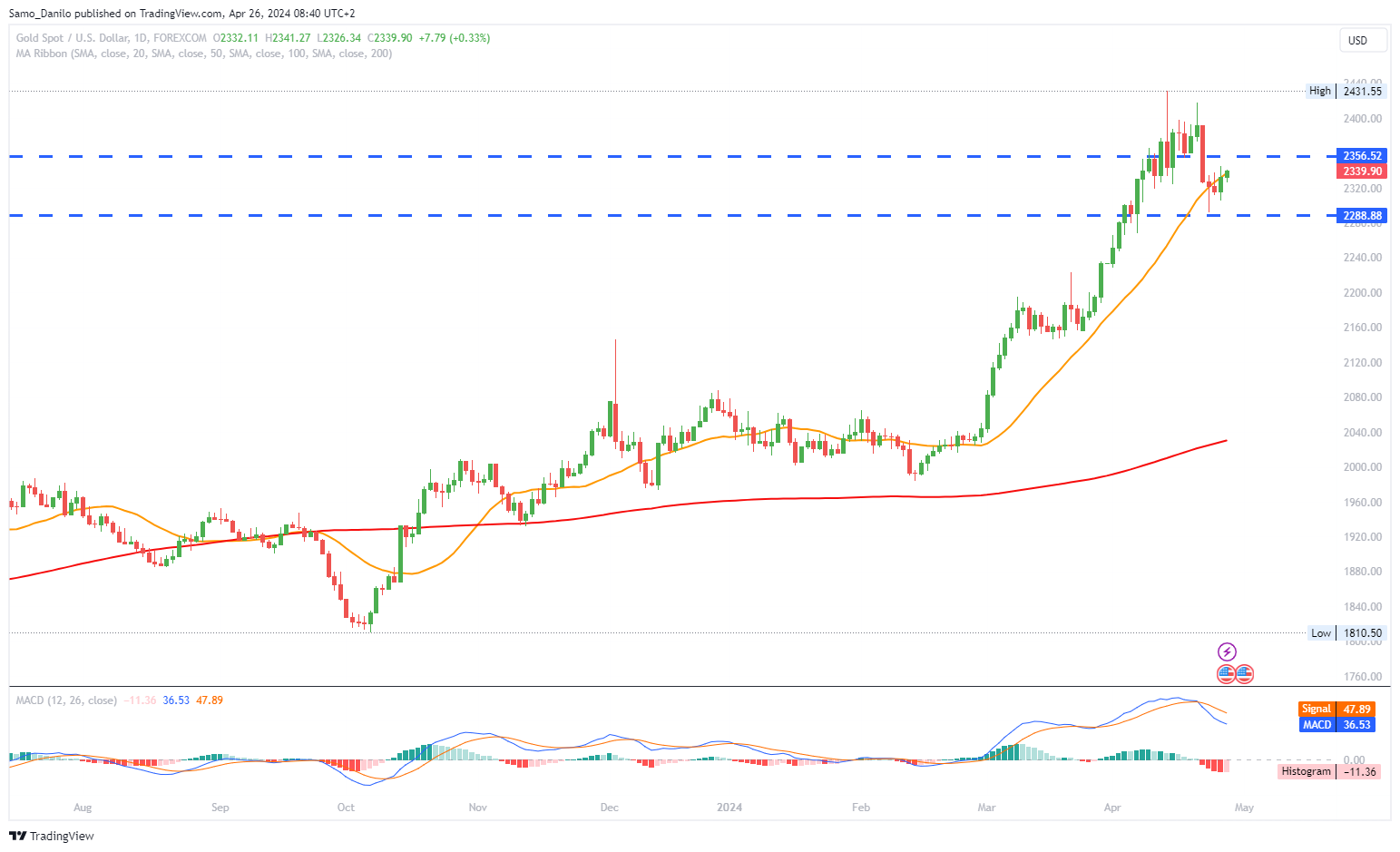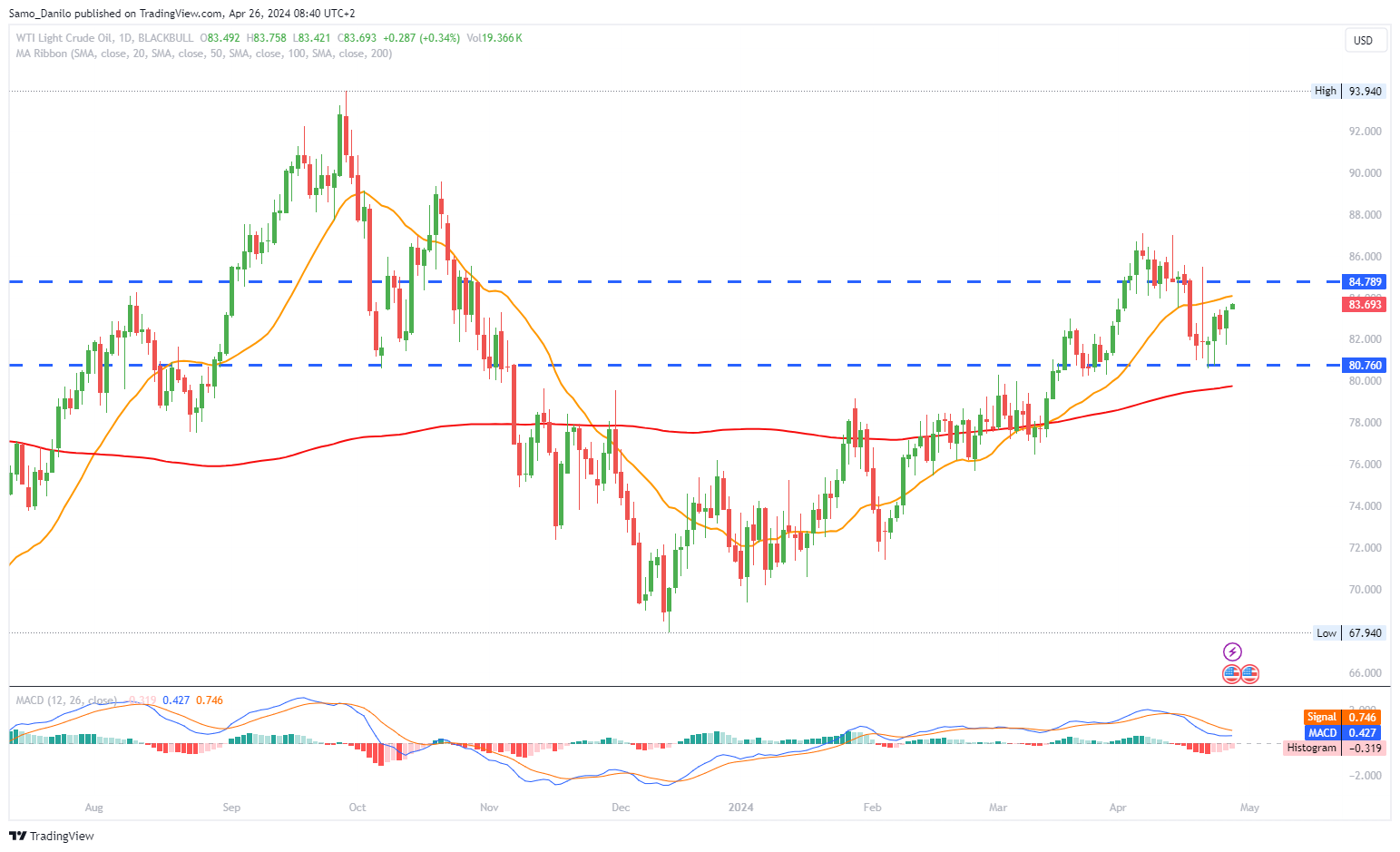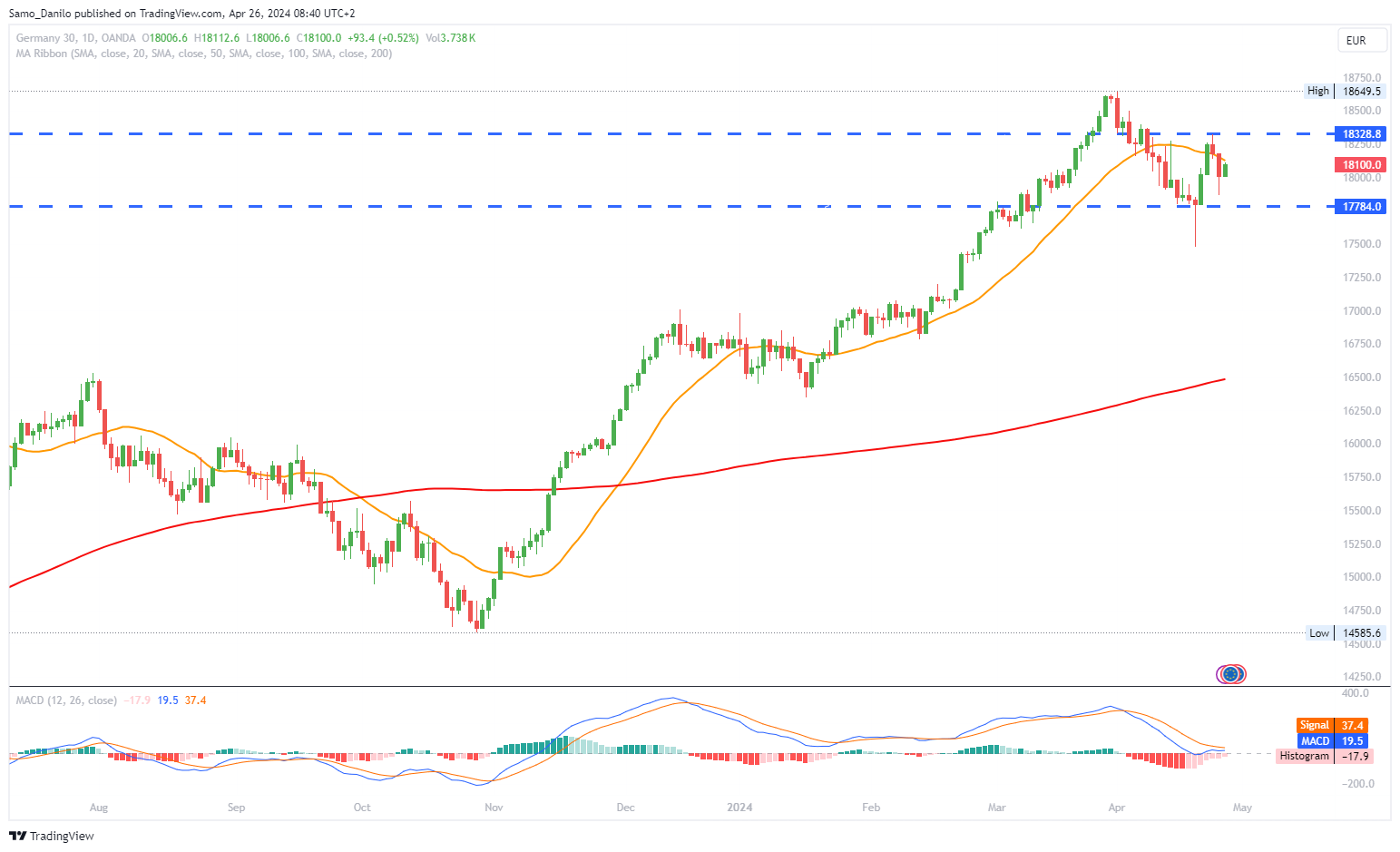EURUSD
- EUR/USD retreated during the Asian session on Friday, pulling back from a recent two-week high near the 1.0740 level reached the previous day.
- The Dollar's decline came after the unexpected miss in the first estimate of the Q1 GDP Growth Rate, despite a rise in quarterly inflation tracked by the GDP deflator. This has pushed back expectations for a potential interest rate cut by the Federal Reserve (Fed) later in the year.
- Recent remarks from ECB board members suggest that the ECB may start its easing cycle in June, with speculation swirling about the possibility of three interest rate cuts (or 75 bps) for the remainder of the year.
- Conversely, expectations for a Fed rate cut in September appear to have waned ahead of the release of key PCE prints on Friday, as investors await further economic data.
- Looking ahead, the Eurozone's relatively subdued economic fundamentals, combined with the resilience of the US economy, support expectations for a stronger Dollar in the medium term, particularly given the likelihood of the ECB cutting rates before the Fed.
Closing statement: EUR/USD retreated from recent highs as investors digested the unexpected miss in the Q1 GDP Growth Rate estimate, dampening expectations for a near-term Fed interest rate cut. Speculation about the ECB initiating its easing cycle in June added downward pressure on the Euro. Despite short-term fluctuations, expectations for a stronger Dollar persist in the medium term, supported by the relatively subdued economic outlook in the Eurozone compared to the resilience of the US economy.
GBPUSD
- GBP/USD is trading lower around the 1.2500 level during the early Asian trading session on Friday, indicating weakness in the British Pound against the US Dollar.
- The US economy's growth slowed to 1.6% in the first quarter (Q1) of 2024, down from 3.4% in the previous reading, falling short of market expectations of 2.5%. This disappointing figure weighed on the US Dollar.
- According to the CME FedWatch tool, the probability of a US Federal Reserve (Fed) interest rate cut in June is less than 10%, with the likelihood of a rate cut in September dropping below 58%.
- Investors are awaiting another inflation report on Friday, with the US Personal Consumption Expenditures (PCE) expected to show a 0.3% month-on-month increase in both headline and core PCE figures, providing further insight into inflation trends.
- On the GBP side, Bank of England (BoE) Governor Andrew Bailey and other policymakers noted that UK inflation had decreased in line with the central bank's expectations, reducing the risk of elevated inflation and potentially paving the way for a rate cut.
| SMA (20) | Falling |
|
|
| RSI (14) | Rising |
|
|
| MACD (12, 26, 9) | Rising |
|
|
Closing statement: GBP/USD traded lower during the early Asian session amid weakness in the British Pound and disappointing US GDP growth figures for Q1 2024. With market expectations leaning towards a reduced likelihood of a US Fed interest rate cut in June and September, investors are closely monitoring inflation reports for further guidance. Additionally, statements from Bank of England officials regarding reduced inflation risk may influence market sentiment towards potential rate cuts in the UK.
GOLD
- Gold price shows indecision and lacks a clear intraday direction, influenced by a mix of conflicting factors impacting market sentiment. The US released its preliminary estimate of Q1 Gross Domestic Product (GDP), revealing a growth rate of 1.6%, below expectations of 2.5% and significantly weaker than the previous quarter's 3.4% growth. This disappointing economic data typically weakens the US Dollar, supporting gold prices.
- Decreased concerns regarding a further escalation of geopolitical tensions in the Middle East weigh on the safe-haven appeal of gold, contributing to downward pressure on its price.
- Despite the easing geopolitical tensions, gold's downside remains limited as USD bulls await more clarity on the Federal Reserve's future interest rate decisions before making significant moves.
- Market focus shifts to the release of the US Personal Consumption Expenditures (PCE) Price Index, a crucial inflation indicator that will play a significant role in shaping the Fed's monetary policy decisions and influencing USD demand.
| SMA (20) | Rising |
|
|
| RSI (14) | Falling |
|
|
| MACD (12, 26, 9) | Falling |
|
|
Closing statement: Gold price experiences mixed influences, as conflicting factors such as disappointing US GDP growth data and easing geopolitical tensions in the Middle East impact market sentiment. While concerns about the US economy typically support gold prices, decreased geopolitical risks weigh on its safe-haven appeal. As investors await further cues on the Federal Reserve's interest rate trajectory, the release of the US PCE Price Index will be closely watched for insights into inflation trends and its implications for future Fed policy decisions.
CRUDE OIL
- Western Texas Intermediate (WTI), the benchmark for US crude oil, is trading around $84.00 on Friday.
- WTI prices initially experienced some selling pressure following the release of the GDP report from the Commerce Department on Thursday. The report indicates that the US economy expanded at its slowest pace in nearly two years in the first quarter of 2024, with inflation rising at a faster pace. This economic data typically weighs on oil prices as concerns about economic growth and demand emerge. However, WTI prices recovered and maintained positive ground after Treasury Secretary Janet Yellen's statement suggesting that US economic growth may have been stronger than indicated by the weaker-than-expected quarterly data. Yellen's remarks likely reassure investors and support oil prices by alleviating concerns about the state of the US economy.
- Geopolitical tensions in the Middle East contribute to the upward pressure on oil prices, as Israel launches airstrikes on Rafah and prepares to invade the city. These developments raise concerns about potential disruptions to oil supply in the region, boosting prices as traders factor in the heightened geopolitical risks.
- Additionally, worries about a significant drawdown in US commercial crude stockpiles further support WTI prices. The Energy Information Administration (EIA) reports that crude inventories for the week ending April 19 fell by 6.368 million barrels, marking the largest drawdown since mid-January. This reduction in inventories signals tightening supply conditions and provides additional bullish momentum to oil prices.
| SMA (20) | Rising |
|
|
| RSI (14) | Slightly Rising |
| |
| MACD (12, 26, 9) | Falling |
|
|
Closing statement: WTI crude oil prices experience a mixed trading session, initially facing selling pressure in response to weaker-than-expected US GDP data but later recovering and maintaining positive ground. Geopolitical tensions in the Middle East and a significant drawdown in US crude inventories contribute to the upward pressure on oil prices, highlighting the complex interplay between economic data, geopolitical developments, and supply dynamics in driving oil market sentiment.
DAX
- The DAX, Germany's leading stock index, maintains its position above the 50-day Simple Moving Averages (SMAs), reaffirming bullish price signals in the market. A sustained move above the key psychological level of 18,000 could provide bullish momentum for the index, potentially targeting the Wednesday high of 18,226.
- German consumer confidence takes center stage on Thursday, with the GfK German Consumer Climate Indicator rising from -27.3 to -24.2 for May. This improvement in consumer sentiment suggests growing optimism among German consumers, which could bode well for domestic consumption and economic activity in the region.
- Economic data from the United States also influences market sentiment, as the US economy expands by 3.1% in the first quarter of 2024, slightly below the 3.4% growth recorded in the previous quarter but exceeding economists' expectations of a 3.0% expansion. Additionally, initial jobless claims decline from 212,000 to 207,000 in the week ending April 20, indicating ongoing strength in the US labor market.
- ECB commentary remains a focal point for investors, particularly regarding the interest rate trajectory after June. Recent German economic indicators have signaled an improving macroeconomic environment, prompting speculation about the future direction of ECB monetary policy. Investors closely monitor ECB officials' remarks for insights into potential policy adjustments and their implications for financial markets.
- Later today, the Personal Income and Expenditures Report from the United States warrants investor attention. This report provides valuable insights into consumer spending patterns and income trends, offering further guidance on the health of the US economy and potential future monetary policy decisions by the Federal Reserve.
| SMA (20) | Slightly Rising |
| |
| RSI (14) | Rising |
|
|
| MACD (12, 26, 9) | Falling |
|
|
Closing statement: The DAX exhibits bullish momentum, supported by positive signals above key technical levels. Improving German consumer confidence and resilient economic data from the United States contribute to market optimism. ECB commentary and US economic reports remain crucial drivers of market sentiment, shaping investor expectations regarding monetary policy and economic growth prospects.
